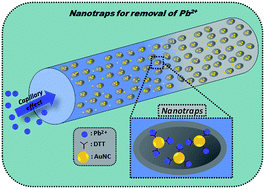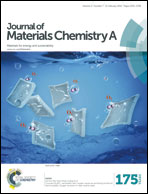“Nanotraps” in porous electrospun fibers for effective removal of lead(ii) in water†
Abstract
Here, we have put in conscientious effort to demonstrate the careful design of binding sites in fibers and their stability for enhanced adsorption of metal ions, which has proven to be a challenging task until now. Dithiothreitol capped gold nanoclusters (AuNCs) are successfully encapsulated into a cavity in the form of pores in electrospun porous cellulose acetate fibers (pCAFs) and their assembly creates a “nanotrap” for effective capture of Pb2+. The enhanced immobilization capacity of AuNCs into the interiors of the fibers and their non-aggregated nature offer enhanced adsorption sites, thus reaching maximum extraction capacity up to 1587 mg g−1 for Pb2+. The remarkable finding from this approach has shown that the diffusion of Pb2+ into the interiors of the AuNC encapsulated porous cellulose acetate fiber (pCAF/AuNC) is in line with the penetration depth of AuNCs. The effectiveness of the pCAF/AuNC has been compared with that of the AuNC decorated non-porous cellulose acetate fibers (nCAF/AuNC). The findings have shown a remarkable improvement in the adsorption efficiency by increasing the availability and stability of adsorption sites in the pCAF/AuNC. We strongly believe that the proposed approach might provide a new insight into developing nanotraps to eliminate the usual limitations including denaturation of adsorbents on supported matrices.


 Please wait while we load your content...
Please wait while we load your content...